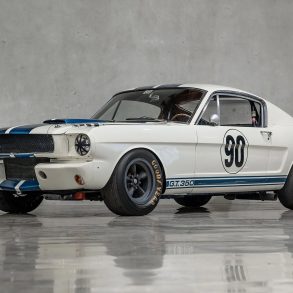
– GM Vice Chairman Bob Lutz in the preface to Driving Style: GM Design’s First Century
Book Review: Driving Style: GM Design’s First Century
By GM Design and MRC Publishing
Published by MRC Publishing, Inc.
200 pages, 276 photographs, 9.50″ x 12″ hardcover
ISBN 978-0-615-26435-6
$75.00 – Order Here
In the early 20th century, automotive design was largely driven by engineers striving for function over form. This process remained largely until 1927, when Alfred Sloan, President of General Motors, hired Hollywood custom coach builder Harley Earl to run the new Art and Colour Section, the world’s first design studio at a major automotive manufacturer. In doing so, Sloan and Earl brought style and appearance to the forefront of automotive design.
Harley Earl’s vision for the 1950s: the 1951 GM LeSabre
In the early days of the automotive industry, designers used full-sized chalkboards to sketch a vehicle. From these, engineers developed wooden sections and used clay to define surfaces. While technology changed, the process, for the most part, did not. In fact, as recently as five years ago, designers used black tape to create drawings, then generated clay models, which were then translated into math surfaces. This resulted in months of redundancies.
Fast forward to today where designers employ the latest computer software to digitally draw and manipulate vehicle concepts.
2007 Buick Riviera Concept
Sculptors, who previously worked in clay, refine the two-dimensional sketches into a three-dimensional math environment. Interior and exterior design concepts are reviewed in a virtual reality design studio that provides a stereoscopic display of design ideas. Designers look at three full-scale vehicles at the same time and can easily modify the selection of vehicles, colors and backgrounds.
Driving Style: GM Design’s First Century
To celebrate the first century of automotive style, General Motors Design and MRC Publishing joined forces to document GM’s first century of automotive designs, from the early stylists to the revered Harley Earl and Bill Mitchell onto the present.
Driving Style is an oversized coffee table book organized into seven chapters, with each section profiling the head of GM Design for their specific era. The names will be familiar to most design enthusiasts, including the aforementioned Harley Earl, Bill Mitchell, Irv Rybicki, Chuck Jordan, Wayne Cherry and current head Ed Welburn.
Each stylist has their own unique look and feel, indicative of the era, their own artistic impressions, and what the public desired (or didn’t desire in some cases).
For instance, inspired by the nation’s fascination with the jet age and GM’s experimental turbine engine program, Harley Earl and GM Styling created the 1952 Firebird I, 1956 Firebird II and 1958 Firebird III concepts.
Harley Earl’s “finned farewell” the 1958 GM Firebird III
This exceptional design carried into the 1960s, when General Motors, driven by Bill Mitchell’s team, at one point accounted for an amazing 62% of all the cars sold in America. The public couldn’t get enough of GM products, from Corvettes and muscle cars to the ever-stylish Buick Riviera.
Automotive design is at its core all about appearance and Driving Style brings home that point with 276 spectacular photos. Better still, 80% of the images have never been seen by the general public or they feature never released concept vehicles.
If you have a favorite GM design, odds are you will find its inspiration. Starting with the Harley Earl-designed 1938 Buick Y-Job – the industry’s first concept car – on the dust cover to the wild Firebird series to the Corvettes to the present, Driving Style covers them all with a great portfolio of pictures.
Fans of General Motors will undoubtedly enjoy Driving Style: GM Design’s First Century, as will anyone that appreciates automotive design. GM Design and MRC Publishing have produced the seminal book on General Motors design at a time when enthusiasts need it most. We hope it’s not the final chapter.
Our favorite design: the Bill Mitchell-designed 1958 Corvette Stingray Race Car.


[Source: GM.com; Photo credit, Driving Style: GM Design’s First Century]












